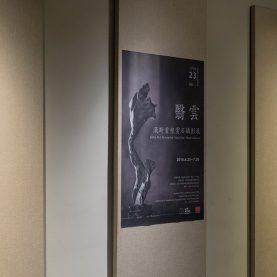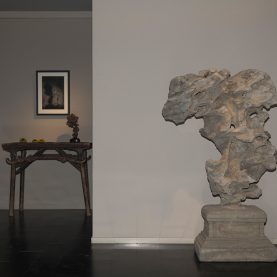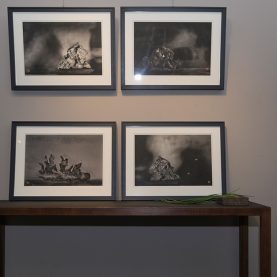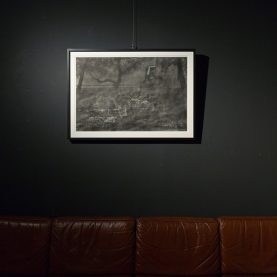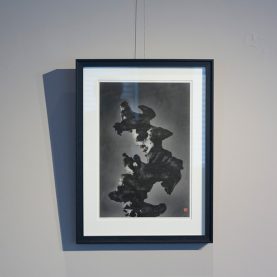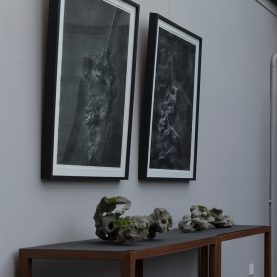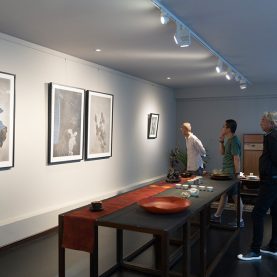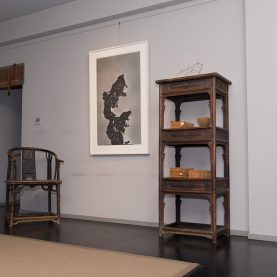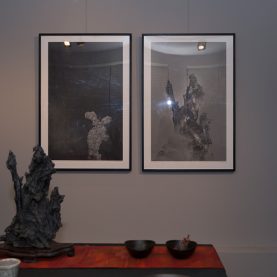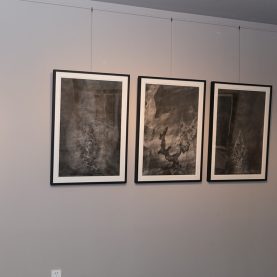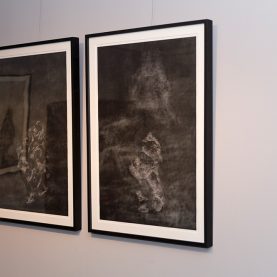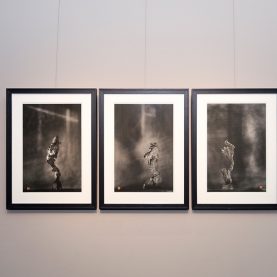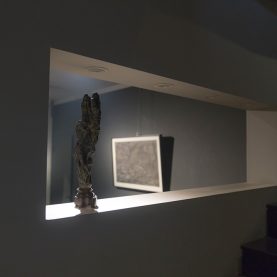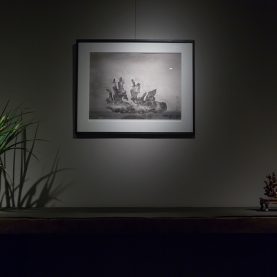
Void Beyond Reality
Emptiness – Photography of Hans Fonk and Scholars’ Rocks
The scholars’ rocks, with its spirit of tranquility, inspiration, insight, and litheness, are celestial. The scholars’ rocks in Fonk’s photography are also celestial. They are not limited by gravity or stereotypes, as they only exist in a secluded and infinite realm.Apparently, Fonk understands the connection between the oriental scholars’rocks and the metaphor they carry to mimic the clouds. He is also keen inrevealing the sacred links among the scholars’ rocks, the universe and the ultimate wisdom of human race.
Hui Chong, as portrayed in The Record of Illustration and Traditional Chinese Painting, is said to have an“unrestrained and carefree spirit”. Being a monk, Hui Chong’s unrestrained spirit here is not about letting his soul go wild; instead, it implies that Huichong has the vision to always look beyond any factual restriction in the world, which is the true meaning of the “carefree spirit” in ancient Chinese culture. In this context, “spirit”, refers to neither a pure abstract conceptnor a concrete entity. Similarly, though Taihu rocks may have various shapes,their spirit still lays along with an identical attitude of being carefree.
Rocks captured in the recent photography work by the Dutch photographer Hans Fonk also possess the spirit of being unrestrained, faint but perceptible. It is fascinating to discovera foreign artist who could comprehend such a subtle spirit like the oriental artist. The reason behind, as I take a wild guess, might be due to the modern knowledge of the universe and the micro substance that he has obtained. Interestingly, one way that an ancient Chinese scholar would appreciate the rocks is to use the most exquisiteand porous rock as the incense burner called Fushan Censer. When the scholars immerse the mselves in the cloud of smoke surrounding the rock, enjoying the spiritual journey, the at mospherewould go quite well with the beats of the modern electronic music from the Western culture. Fonk might have no knowledge of such a way for rock appreciation, but it is possible that he has sensed the similar spirit whetherhe is a fan of electronic music or not.
As an ancient Chinese saying goes:“The wise man finds the pleasure in water while the virtuous finds it inmountains.” But the scholars’ rocks are beyond water and mountains, andtherefore it is the combination of the wisdom and the virtue. Thisunderstanding is essential for the appreciation of rocks and the aesthetics ofagnosticism. The Chinese scholars love their rocks. They collect them,appreciate them and are obsessed with them. Through those practices, thescholars discover their identity, cultivate their temperament, and gaininspiration from the rock’s spirit. Any foreigners who have visited the SuzhouGarden or the study of Chinese literati would sense the strong aesthetic emblemof those scholars’ passion for rocks.
Although Fonk may not know theanecdotes from Song Dynasty of Mi Dian’s admiration towards rocks nor EmperorZhao Ji’s special boat for transporting exquisite rocks, but I would not besurprised if he had seen the Ten Views of a Lingbi Rock by Wu Bin fromthe late Ming Dynasty, devoted to the owner of the Lingbi rock, Mi Wanzhong.Fonk’s photography work and Wu’s painting are uncannily parallel in the way ofexpressing the spirit of scholars’ rocks: its vagueness and impermanence, justlike the collected or scattered clouds, are apparent in their works. Bothartists choose the background that is neither foggy nor smoky, but appearing asthe mist wreathing the rocks.
In the past, Lang Jingshan’sphotograph works of landscape embodied the spirit and momentum of Chinesetraditional landscape painting. Japanese photographs have also conveyed thesimilar sentiment and reflected the taste of ancient scholars. However, comingfrom the Western culture, it is mystical how Fonk fells in love with thesemarvelous rocks at first sight. His photography is a recreation of thescholars’ rocks through the interaction of clearness and vagueness, bothphysically and spiritually. With the light and darkness, Fonk has delivered hisown interpretation of the rocks’ spirit and created his own secluded andinfinite space.
The mystical nature of scholars’ rock,apart from its exotic shape, is also largely determined by the use of the lightand the smoke. Through a sketcher’s eye, Fonk meticulously captures thesilhouette of the rocks under the changing light and smoke, and utilizes theserene setting to realize the beauty of his images. As the Zen saying goes: “Inmorning’s first light, moon and wind abate. From the remote antiquity, sky isever present.” Fonk’s photography reminds us that such bright moonlight andeternal firmament can also exist in the darkness.
Amidst the darkness,scholars’ rock is the seed of vagueness, and it germinates ideas and generatesmomentum. Fonk fully grasps the essence of scholars’ rock by emphasizing on thehollowness, revealing its primitive form through lights and shadows, andshowing us how a heart of serenity is the true nature of our universe.
2018 Summer




